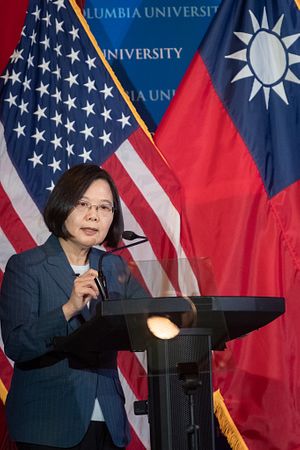Taiwan faces an existential threat. China considers it a renegade province, is actively trying to isolate it from the rest of the world, and reserves the right to forcibly annex it. Although the Chinese Communist Party (CCP) has long believed in a “sacred duty” to assert political control over the island nation, its current leader, Xi Jinping, is growing impatient and is clearly unwilling to let Taiwan become the next generation’s “problem.”
Despite the stakes, Taiwan’s military has not always been particularly creative in how it planned to defend the island. For decades, it was content to depend upon a small inventory of expensive, but obsolete, American-made jets and ships. The thinking rested on two assumptions: Taiwan had to hold out long enough for the United States to intervene. And the United States’ willingness to sell outdated weapons somehow signaled its willingness and ability to defend Taiwan in a war with China.
China’s decades-long military modernization efforts, as well as its extensive anti-access capabilities, call both assumptions into question.
Thankfully, President Tsai Ing-wen is pushing Taiwan’s military leaders to come up with something better. Taiwan’s new Overall Defense Concept (ODC) stands out as a particularly important result of her willingness to challenge old military shibboleths. The brainchild of Taiwan’s recently retired Chief of the General Staff, Admiral Lee Hsi-ming, ODC acknowledges that Taiwan cannot afford to match China jet for jet or ship for ship. Instead, ODC seeks to deter China by making an invasion unacceptably difficult and costly using large numbers of inexpensive weapons, including anti-air missiles, missile boats, and naval mines.
ODC is a fresh, innovative step in the right direction. It is a smarter way to use Taiwan’s relatively small defense budget. It builds on ideas and concepts that U.S. defense experts have long advocated. And it leverages Taiwan’s natural defensibility while exploiting the inevitable obstacles associated with projecting military power over water. For all these reasons, ODC is far more credible than the defense plans that preceded it
Unfortunately, it is not a foregone conclusion that ODC will succeed. Obstacles remain. In particular, expensive legacy programs threaten to consume Taiwan’s small defense budget, preventing full investment in asymmetric weapons.
The Indigenous Diesel Submarine (IDS) program, which involves designing and building eight diesel-electric attack submarines over the next 10 years, exemplifies the problem.
Topping the list of challenges is price. It could cost Taiwan up to $5 billion just to design and build the first four submarines alone, not including long-term maintenance costs or the other four submarines. Worse yet, IDS will almost certainly cost more and take longer than planned. Submarines are technically challenging, and Taiwan’s shipbuilding industry has no experience building one. Taiwan’s entire defense budget last year was $11 billion — there is simply no way Taiwan can afford both legacy programs like IDS and genuinely transformative concepts like ODC.
Nor is it entirely clear that submarines are the best option to deter a cross-Strait invasion. First, time is not on Taiwan’s side. It needs a credible cross-Strait deterrent now, but it will take Taiwan years to field a viable IDS fleet. Plus, the limited number of submarines Taiwan can produce are unlikely to change Chinese perceptions of success. Any conceivable invasion scenario would begin with a preemptive strike against Taiwan’s military forces, of which IDS would be among the highest priority targets. Given rotation and maintenance requirements, an eight-ship IDS force would likely have only a small number, maybe two or three, submarines deployed on a day-to-day basis, leaving the rest vulnerable in port.
These operational shortcomings notwithstanding, there is at least one compelling political argument in favor of IDS. The program benefits Taiwan’s shipbuilders, shoring up support from an important domestic interest group. Yet, even here the expected benefits are overstated. After all, Taiwan awarded the contract to a European defense firm, which means that $1.6 billion — or over 30 percent of the initial price tag — is heading overseas.
Meanwhile, even from a purely political perspective, there are more effective ways to spend Taiwan’s scarce defense dollars. Many of the genuinely asymmetric weapons needed to implement ODC will likely require investing in things that Taiwan’s economy is already good at producing (unlike submarines). Drones, smart mines, and artificial intelligence are precisely the kind of innovative technologies needed to make ODC a reality. These are capabilities that Taiwan is already well positioned to develop and build.
Tsai is pushing Taiwan’s military to embrace a more sustainable and credible defense posture. ODC proves that Taiwan’s most dynamic and innovative military leaders have the right ideas to follow her lead. The United States can help. It should encourage Taiwan to scrap programs — ranging from building indigenous submarines to buying U.S. main battle tanks and self-propelled howitzers — that do not match ODC’s priorities. Furthermore, the United States should even consider offering to support Taiwan’s indigenous defense capabilities by purchasing limited numbers of genuinely asymmetric weapons that it might produce.
The danger to Taiwan is real. The stakes are too high — and ODC is too important — for the United States to let it languish as outdated programs consume the resources that Taiwan needs to make its defense transformation a reality.
Michael A. Hunzeker is an assistant professor at the Schar School of Policy and Government.
Joseph Petrucelli is a Ph.D. student at the Schar School of Policy and Government and a U.S. Navy Reserve Officer. The analysis and opinions expressed here are his alone and do not represent those of the Department of Defense.
































